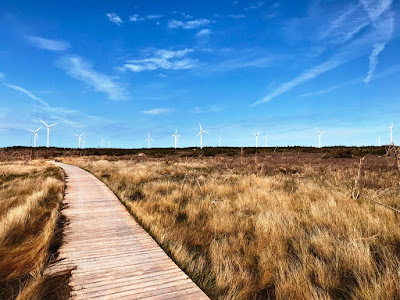Charlottetown is the largest city on Prince Edward Island and the provincial capital.
The seat of government is
Province House, completed in 1847, and shown in the photo below. This
national historic site is currently closed for several years for renovations. During the renovations, the provincial legislature is meeting in the Honorable George Coles Building located east of Province House.
The main cultural center in Charlottetown is the
Confederation Centre of the Arts, completed in 1964, and shown in the photo below. This building complex includes a large mainstage theater (the Homburg Theatre), an art gallery, library, restaurant, and shopping. The Confederation Centre occupies an entire city block west of Province House.
Prince Edward Island is known as the "Birthplace of Confederation" or the "Cradle of Confederation" because of the
Charlottetown Conference held in Province House in September 1864. This historic conference was the first formal step in the process that led to
Canadian Confederation, the formation of Canada as a country, on July 1, 1867. (Canadians celebrate
Canada Day on July 1.)
Normally there is an exhibit about the 1864 Charlottetown Conference in Province House, but the exhibit, shown in the photo below, has been moved to the Confederation Centre of the Arts while Province House is being renovated. The 20-minute video "
A Building of Destiny," which was part of the exhibit, is an excellent documentary about this important part of Canadian history.
Charlottetown is named for Queen Charlotte, wife of King George III. There were many things in the city named "George": Province House is located at the end of Great George Street and
The Great George Hotel hosted some of the delegates to the 1864 Charlottetown Conference.
Alas, we did not stay at The Great George Hotel, but we had excellent accommodations a few blocks away from Province House at Cranford House, pictured below with our car, part of the
Fairholm Inn properties.
Prince Edward Island is the smallest Canadian province. It is approximately one quarter the size of Vermont in both area and population. Nearly half the population of PEI lives in the Charlottetown metro area, yet the central city is compact and very walkable. The city is located on Charlottetown Harbor which opens onto Hillsborough Bay which in turn opens onto the Northumberland Strait between PEI and the mainland (New Brunswick and Nova Scotia). There is a pleasant boardwalk along Charlottetown Harbor:
One of the fun things we did in Charlottetown was to follow the trail of Eckhart the Mouse, starting at the Visitor Information Centre on the waterfront which had a brochure about the trail.
This news article from 2009 provides interesting background about the trail.
















































